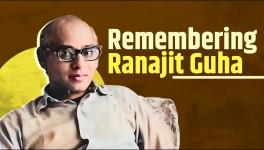Remembering Ranajit Guha
Image Courtesy: National Herald
Subaltern studies emerged in India as a postcolonial theory to redraft people’s history from below. Its prime objective is to emphasise the history of the oppressed in antagonism to the elite perspective of history that tends to ignore their contributions. This trend began with writing the history of peasant insurgencies and tribal insurrections. And the project was ascribed to Prof Ranajit Guha, followed by a group of scholars including Partha Chatterjee, David Hardiman, Shahid Amin, David Arnold, Dipesh Chakrabarty, and others. Besides them, Dr Bhimrao Amedkar’s role is significant in contributing theory and practice to the uplift of Dalits.
Guha’s view is that the nationalist movement has no substance if it neglects the contribution of the subaltern classes. Dominant elitist historiography overlooks narratives about peasants and tribal communities, especially their struggles during colonial rule over India. The elites of history-writing tend to chronicle the “idealist and ambiguous aspect of the indigenous elites who led people from subjugation to freedom”. Their school of thought emphasises the role of a few individual leaders or organisations but fails to interpret and acknowledge the relentless efforts of those subalterns who fought for freedom independently.
In his 2013 article, “On Some Aspects of the Historiography of Colonial India”, Guha observes that the Indian freedom struggle was hijacked by bourgeois nationalists whose writings give the impression that they attained for our nation its consciousness of nationalism. This elitist perspective portrays uprisings as a “law and order problem” and projects Indian nationalism as the outcome of a few charismatic leaders. On the other hand, Guha’s project was to illustrate how, parallel to the politics of the elite classes, subaltern classes had a considerable role in the Indian nationalist movement. That does not mean subaltern politics is an offshoot of elite politics but unique and autonomous to elite-driven politics.
In Guha’s work, one finds a critique of the personalised accounts one finds in establishment historiography about the benevolence of native elites. These figures may have had a strong aversion to the colonial regime. But history has shown us that the elites were also oriented to grab power and privileges from the British Raj and, therefore, tended to be exploiters, collaborationists, and oppressors of the masses. He assessed that such a history of Indian nationalism is a “sort of spiritual biography of Indian elites”. The subaltern project argues that the resistance of tribal, peasant, and other subalterns against the Britishers emerged from the people—not the elites. Therefore, he helped historians recognise the elite-people binary and emphasised that mobilisation was a critical aspect of politics. His other crucial contribution was the acknowledgement that elite political mobilisation during the freedom struggle was an outcome of the mobilisation of subaltern politics secured from the below. Traditional institutions such as caste, clan, family, territoriality, kinship, and deprivation supported the process. Guha observes that subaltern classes mobilise aggressively, intensely, violently, and spontaneously—unlike their elite counterparts who take the more legalistic and controlled approach.
In “Elementary Aspects of the Peasant Insurgency in Colonial India (1983)”, Guha argues that the most significant task of the subaltern project is to create the “history of the people”. This paper is an intriguing account of peasant consciousness and resistance alongside the religiosity, mystic visions, solidarity, and other bonds that communities share.
In the first volume of his book, Subaltern Studies, published in 1982, Guha described why subaltern class initiatives are not powerful enough to develop a full-fledged struggle. In his opinion, the working class had not sufficiently matured as a “class-for-itself”, nor was it strongly allied with the peasantry. As a result, the subaltern could not take over and complete the objectives of the struggle the elite class had failed to realise. His concern that the plight of the peasants is not acknowledged reinforced numerous struggles in India. In the same volume, he speaks about “new democracy” as the study of the failure which constitutes the “central problematic of the historiography of colonial India”. He writes, “Let a hundred flowers blossom and we don’t even mind the weeds” to observe that even the elitist have a role in historiography “if only by way of teaching only negative examples”.
Guha dexterously reframed the past to change the arena of historiography aimed at transforming the consciousness. His indelible legacy has enlightened academics to pose questions on subaltern and postcolonial studies, which may often have no ready answers. The term subaltern used by Antonio Gramsci first referred only to the peasants and workers—those under the hegemony of the ruling and powerful classes. In the eighties, Guha and his colleagues modified the elite-centric academia in South Asian studies. To them, the etymological meaning associated with “subaltern” implies anyone from an “inferior rank” in class, gender, caste or official position. This description says everything about how the influence of subaltern studies was bound to spread across the world.
Guha would have turned 100 years old this month, but he left us on 28 April in a world still grappling with uncertainty. His vast oeuvre will enlighten academia in the coming years, always raising questions, though the answers may never be adequate. Rest in power, professor!
The author is an assistant professor, Department of Sociology, Maitreyi College, University of Delhi. The views are personal.
Get the latest reports & analysis with people's perspective on Protests, movements & deep analytical videos, discussions of the current affairs in your Telegram app. Subscribe to NewsClick's Telegram channel & get Real-Time updates on stories, as they get published on our website.















